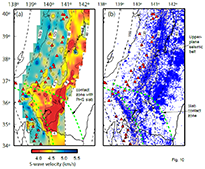** Progress in Earth and Planetary Science is the official journal of the Japan Geoscience Union, published in collaboration with its 51 society members.
** Progress in Earth and Planetary Science is partly financially supported by a Grant-in-Aid for Publication of Scientific Research Results to enhance dissemination of information of scientific research.
Gallery View of PEPS Articles
Review
Solid earth sciences
201704201704
Seismic imaging of slab metamorphism and genesis of intermediate-depth intraslab earthquakes
Hasegawa A, Nakajima J
Internal slab structure, slab metamorphism, dehydration-related embrittlement, intermediate-depth earthquake, intraslab earthquake, earthquake generation mechanism, subduction zone
Fig. 1 (a) P–T paths of the subducting crust for six subduction zones. Shading shows maximum H2O contents in wt%. (b) Accumulated dehydration-derived H2O content in wt%, (c) rate of H2O production and (d) total system (solid + H2O) volume for Hokkaido (blue lines) as a representative cold slab, and for Kii (red lines) as a representative warm slab. In (c), Kii is scaled by a factor of 10. (e) Frequency of upper-plane earthquakes beneath central Hokkaido as a function of depth.
Fig. 2 (a) S-wave velocity distribution and (b) earthquake hypocenters within the crust of the Pacific slab. A belt of upper-plane seismicity is shown in pink. Broken black curves denote iso-depth contours of the upper plate surface. The slab–slab contact zone between the Pacific and Philippine Sea slabs is enclosed by two green broken curves.
We review studies of intermediate-depth seismicity and seismic imaging of the interior of subducting slabs in relation to slab metamorphism and their implications for the genesis of intermediate-depth earthquakes. Intermediate-depth events form a double seismic zone in the depth range of c. 40–180 km, which occur only at locations where hydrous minerals are present, and are particularly concentrated along dehydration reaction boundaries. Recent studies have revealed detailed spatial distributions of these events and a close relationship with slab metamorphism. Pressure–temperature paths of the crust for cold slabs encounter facies boundaries with large H2O production rates and positive total volume change, which are expected to cause highly active seismicity near the facies boundaries. A belt of upper-plane seismicity in the crust nearly parallel to 80–90 km depth contours of the slab surface has been detected in the cold Pacific slab beneath eastern Japan, and is probably caused by slab crust dehydration with a large H2O production rate. A seismic low-velocity layer in the slab crust persists down to the depth of this upper-plane seismic belt, which provides evidence for phase transformation of dehydration at this depth. Similar low-velocity subducting crust closely related with intraslab seismicity has been detected in several other subduction zones. Seismic tomography studies in NE Japan and northern Chile also revealed the presence of a P-wave low-velocity layer along the lower plane of a double seismic zone. However, in contrast to predictions based on the serpentinized mantle, S-wave velocity along this layer is not low. Seismic anisotropy and pore aspect ratio may play a role in generating this unique structure. Although further validation is required, observations of these distinct low P-wave velocities along the lower seismic plane suggest the presence of hydrated rocks or fluids within that layer. These observations support the hypothesis that dehydration-derived H2O causes intermediate-depth intraslab earthquakes. However, it is possible that dual mechanisms generate these earthquakes; the initiation of earthquake rupture may be caused by local excess pore pressure from H2O, and subsequent ruptures may propagate through thermal shear instability. In either case, slab-derived H2O plays an important role in generating intermediate-depth events.







